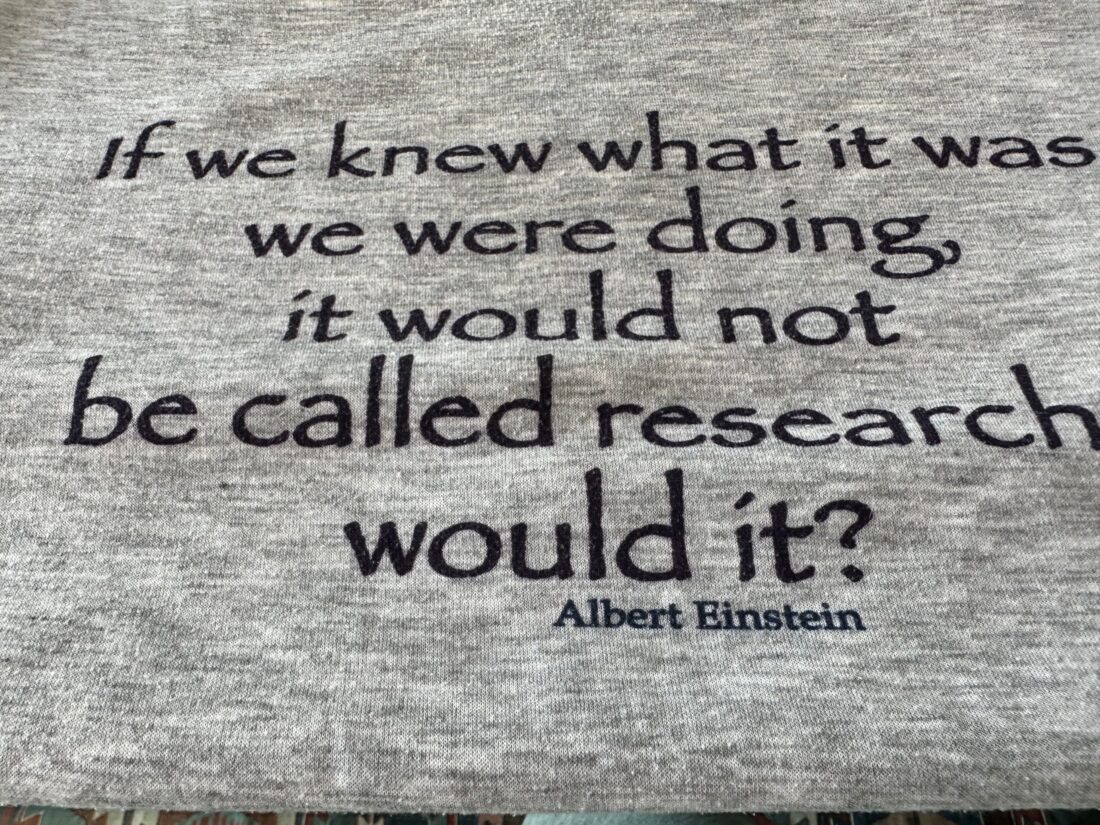 The picture above was taken from my favorite T-shirt, which features my favorite quote. It is also the main reason that I chose an academic career: to get a license to experiment. When I wear the shirt, it often triggers mixed responses despite Einstein’s name on the bottom. Often, people argue that there is a world of difference between not knowing what we are doing and investigating the unknown. From my perspective, regardless of interpretation, the quote strongly encourages experimentation with full knowledge that there is a high probability that most of the experiments will fail.
The picture above was taken from my favorite T-shirt, which features my favorite quote. It is also the main reason that I chose an academic career: to get a license to experiment. When I wear the shirt, it often triggers mixed responses despite Einstein’s name on the bottom. Often, people argue that there is a world of difference between not knowing what we are doing and investigating the unknown. From my perspective, regardless of interpretation, the quote strongly encourages experimentation with full knowledge that there is a high probability that most of the experiments will fail.
This is my 4th blog (starting with my Earth Day 2023 blog from April 25) about attempts to incorporate our changing reality into the strategic plan of my place of work. This time, the focus is on research.
Research and education go hand in hand in the role of every accredited university. This parity extends throughout history:
A university (from Latin universitas ‘a whole’) is an institution of higher (or tertiary) education and research which awards academic degrees in several academic disciplines. Universities typically offer both undergraduate and postgraduate programs. In the United States, the designation is reserved for colleges that have a graduate school.
The word university is derived from the Latin universitas magistrorum et scholarium, which roughly means “community of teachers and scholars”.[1]
The first universities in Europe were established by Catholic Church monks.[2][3][4][5][6] The University of Bologna (Università di Bologna), Italy, which was founded in 1088, is the first university in the sense of:
-
Being a high degree-awarding institute.
-
Having independence from the ecclesiastic schools, although conducted by both clergy and non-clergy.
-
Using the word universitas (which was coined at its foundation).
-
Issuing secular and non-secular degrees: grammar, rhetoric, logic, theology, canon law, notarial law.[7][8][9][10][11]
Before I proceed further, I have to add a word about the designation of my working place as “University.” Wikipedia defines a university as a “college that has a graduate school.” As mentioned earlier, my working place is the City University of New York (CUNY). It goes far beyond a single graduate school. As our present Chancellor said, CUNY is:
…the premier and largest urban public university in the United States, serving approximately 226,000 degree-seeking students, 150,000 in adult and continuing education programs, and 40,000 faculty and staff at our 11 four-year colleges, seven community colleges and seven graduate and professional schools.
I am associated with Brooklyn College and the CUNY Graduate Center.
Individual colleges and universities are subject to periodic external evaluation by accredited agencies:
The goal of accreditation is to ensure that education provided by institutions of higher education meets acceptable levels of quality. Here you will find a list of accrediting agencies recognized by the U.S. Secretary of Education as reliable authorities concerning the quality of education or training offered by the institutions of higher education or higher education programs they accredit.
Students apply to individual colleges. Every college has its own strategic plan that is publicized on its website, for applying students to consider. However, in a federated university like ours, the college’s strategic plan has to conform with its university’s strategic plan. CUNY is a public university, whose goal is to enable every qualified student to enter, regardless of economic considerations. To accomplish this mission, CUNY, and hence its individual colleges, need public support. Because of CUNY’s structural complexities, public support comes from both New York State and the City. Present budget allocations for next year were announced recently (the Chancellor’s comments, quoted above, were part of this process). State and City governments are carefully looking at the strategic plans for indications that the public institution can make significant contributions that will benefit the general public in their constituencies.
Much of the support for the research that runs on US college campuses comes from the Federal Government rather than directly from the locality in which the school resides. The agency that supports much of this research is the National Science Foundation (NSF) (put NSF in the search box to find earlier entries on this agency). The NSF doesn’t look at the strategic plan of the researchers’ school (they look at the school to examine other aspects). The NSF wants to make sure that they are funding, on a competitive basis, the best proposals submitted as far as the quality of the science is concerned. However, an important consideration in the funding is the concept of “broader impact,” which the NSF defines as follows:
The Broader Impacts discussion is a critical component of any proposal submitted to the U.S. National Science Foundation. It answers the following question: How does your research benefit society?
The concept of broader impacts is not yet officially recognized on a local level, but unofficially, it is an important part of any lobbying activities for more resources.
Next week’s blog will try to look at the broader impacts of the Brooklyn College (BC) strategic plan.
